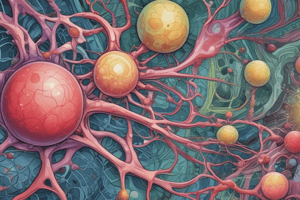Podcast
Questions and Answers
What is the function of the cell membrane?
What is the function of the cell membrane?
- To control the movement of substances into and out of the cell (correct)
- To synthesize proteins
- To store genetic material
- To provide support and shape to the cell
What is the function of chloroplasts in plant cells?
What is the function of chloroplasts in plant cells?
- To synthesize proteins
- To store genetic material
- To provide support and shape to the cell
- To carry out photosynthesis and make food (correct)
What is the term for the genetic material that contains all instructions needed for cellular activities?
What is the term for the genetic material that contains all instructions needed for cellular activities?
- Chromosome
- DNA (deoxyribonucleic acid) (correct)
- Cytoplasm
- Nucleus
What is the number of pairs of chromosomes found in a male's genetic material?
What is the number of pairs of chromosomes found in a male's genetic material?
What is the term for a disorder caused by an additional or missing chromosome?
What is the term for a disorder caused by an additional or missing chromosome?
What is the final step in the cell division process?
What is the final step in the cell division process?
What is the general shape of a mature red blood cell?
What is the general shape of a mature red blood cell?
What is the purpose of adding a solution to the object on the slide?
What is the purpose of adding a solution to the object on the slide?
What happens when you turn the coarse adjustment knob?
What happens when you turn the coarse adjustment knob?
What is the function of the cover slip?
What is the function of the cover slip?
What is the purpose of the eyepiece in a microscope?
What is the purpose of the eyepiece in a microscope?
What is the general shape of an ovum?
What is the general shape of an ovum?
What is the purpose of using a light source when using a microscope?
What is the purpose of using a light source when using a microscope?
What is the formula for calculating the magnification of a microscope?
What is the formula for calculating the magnification of a microscope?
Flashcards are hidden until you start studying
Study Notes
Cells
- All living things are made up of cells.
- Types of cells: unicellular (e.g., amoeba, paramecium, bacterium) and multicellular organisms.
Types of Human Cells
- Nerve cells
- Red blood cells: biconcave disc shape
- Muscle cells
Cell Structures and Functions
Animal Cell
- Cell membrane: controls the movement of substances into and out of the cell
Plant Cell
- Cell wall: protects, supports, and gives regular shape to the cell
- Large vacuole: contains mainly water and stores dissolved minerals
- Chloroplast: where photosynthesis takes place to make food
Common Cell Structures
- Nucleus: contains genetic materials (DNA)
- Cytoplasm: where chemical reactions (e.g., respiration) take place
- Cell membrane: controls the movement of substances into and out of the cell
Genetic Materials
- DNA (deoxyribonucleic acid): contains all instructions needed for the cell to carry out activities
- Function: determines features and characteristics inherited from parents
Cell Division
- Procedure:
- Genetic materials make a copy of themselves
- Nucleus divides into two
- Cytoplasm divides into two
- Two daughter cells are formed (with nucleus)
- Daughter cells absorb nutrients and grow bigger
Abnormal Cell Division
- Cancer: cells divide abnormally
Microscope
- Purpose: to observe cells that are too small for the naked eye
- Types: light microscope (2D), electron microscope (3D)
- Structure:
- Cover slip: to keep the specimen (e.g., onion skin) flat and prevent drying out
- Magnification:
- Formula: Magnification = eyepiece x objective
- Longer eyepiece: lower magnification
- Longer objective: higher magnification
Microscope Usage Procedure
- Steps:
- Take the microscope on the arm and base
- Place near a light source
- Choose lower-power eyepiece and objective
- Adjust brightness
- Prepare specimen (e.g., onion skin, animal cell)
- Place specimen on slide, add solution, and cover with a cover slip
- Place slide on stage and hold in place with clips
- Observe with both eyes open
- Adjust coarse and fine adjustment knobs for a clear image
- Use higher magnification objective for further magnification
- Use fine adjustment knob only for focusing
Image Produced by Microscope
- Magnified and inverted
- Move left, see move right; move towards yourself, see move away from you
Sex Cells
- Sperms:
- Have head and tail
- Tail enables sperm to swim
- 23 chromosomes with 1 sex chromosome (50% X, 50% Y)
- Ova (Egg):
- Spherical shape
- Surrounded by a jelly coat
- Cannot move by itself
Studying That Suits You
Use AI to generate personalized quizzes and flashcards to suit your learning preferences.




